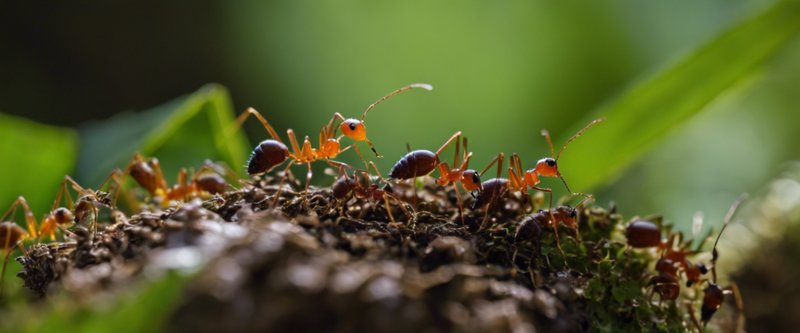
Now, before we dive deeper into their role, let’s clarify what fire ants are. Native to South America, these pests have made their way to the southern United States and other parts of the world. Their nickname comes from the painful sting they deliver when disturbed—which feels like getting burned! But there’s more to them than their fiery reputation. Let me explain how they fit into the bigger picture of our environment.
What Are Fire Ants?
Fire ants belong to the genus *Solenopsis*, and there are several species, with the red imported fire ant (*Solenopsis invicta*) being the most notorious. These ants are easily recognizable due to their reddish-brown color and aggressive behavior. They live in colonies that can range from a few hundred to several hundred thousand ants.
These colonies often build large, visible mounds in the soil, which serve as their headquarters. This is where they raise their young and store food. You might find fire ants in open fields, parks, and even your yard, causing trouble when they nest too close to human activity.
Fire ants are social insects, meaning they work together in a highly organized manner. Each ant has a role—workers gather food, defend the nest, and care for the queen and her brood. Their ability to work as a team is crucial for their survival. But it also means that if you disturb their nest, you might quickly find yourself on the receiving end of a swarm of angry ants!
Fire Ants: Nature’s Soil Aerators
Here’s the thing: while fire ants can be a nuisance, they also play a role in improving soil health. By tunneling through the earth, they help aerate the soil. This action allows water and nutrients to flow deeper, benefiting plants in the area. Think of it like a natural garden maintenance crew, working hard to ensure that the soil is rich and capable of supporting various plant life.
Furthermore, as fire ants forage for food, they move organic matter into their nests. This process helps decompose materials and enriches the soil with nutrients. So, in a way, fire ants contribute to a healthier ecosystem, even if their presence isn’t always welcomed by us humans.
The Impact on Other Wildlife
Fire ants are also key players in the food chain. They serve as a source of food for various animals. Birds, reptiles, and some mammals rely on fire ants as part of their diet. For example, certain species of birds have adapted to feed on these ants and may even pick them off the ground or from the mounds.
However, it’s not all sunshine and rainbows. Fire ants can negatively impact other wildlife, especially when they invade new areas. They can outcompete native insects for food and resources. Some studies show that their presence can lead to the decline of certain species that are unable to cope with their aggressive behavior. This imbalance can ripple through the ecosystem, impacting everything from plant health to population dynamics.
Fire Ants and Plant Life
Let’s talk about how fire ants interact with plants. These ants can be beneficial for certain plants, especially in protecting them from herbivores. Some plants, like the Acacia tree, establish a mutualistic relationship with fire ants. In return for shelter and food, the ants will protect the tree from insects that might harm it.
On the flip side, fire ants can be harmful to young plants and seeds. They can disrupt root systems by tunneling and may consume seeds, preventing them from germinating. This can be particularly problematic for agricultural areas where crops are being established.
So, while fire ants can provide certain benefits, their impact on plant life can be quite complex. It’s essential to understand that their presence requires a balance, impacting everything from biodiversity to agriculture.
Fire Ant Control: A Double-Edged Sword
When dealing with fire ants, many people think of eradication. It’s tempting to simply get rid of them, especially if they’re invading your garden or yard. However, controlling fire ant populations isn’t as straightforward as it seems.
Using pesticides may temporarily reduce their numbers, but they can also harm beneficial insects and disrupt the ecosystem further. Instead, consider targeted approaches—like baiting strategies that will eliminate the colony without significantly affecting the surrounding wildlife.
In some cases, fostering the presence of natural predators, like certain birds or other insect species, can help keep fire ant populations in check. Here’s the thing: controlling fire ants requires a thoughtful approach to protect the delicate balance of the ecosystem.
Is Coexistence Possible?
You might be wondering if it’s possible to coexist with fire ants without them becoming a nuisance. While it’s challenging, it’s not impossible. Keeping your yard clean and free from food debris can help to minimize encounters with them. Additionally, providing habitat for natural predators can encourage a balanced ecosystem.
In agricultural settings, using techniques like crop rotation and polyculture can help mitigate the impact of fire ants on crops. It’s all about finding ways to encourage beneficial relationships while keeping the downsides in check.
Ultimately, understanding the role of fire ants in ecosystems helps us appreciate these little creatures more, even if they do pack a painful sting. By learning to balance their presence, we can enjoy the benefits they bring without letting them run amok.
Fire ants are fascinating creatures that play a multifaceted role in ecosystems. From improving soil health to acting as a food source for other wildlife, they contribute to the complex web of life around us. While they can be a nuisance, recognizing their importance can lead us to better ways of living alongside them.
By embracing a thoughtful approach to managing fire ant populations, we can protect both our immediate environment and the broader ecosystem. So, the next time you see a fire ant, remember—there’s more to them than just that sting! Understanding their role in our world can help foster a more balanced coexistence.
